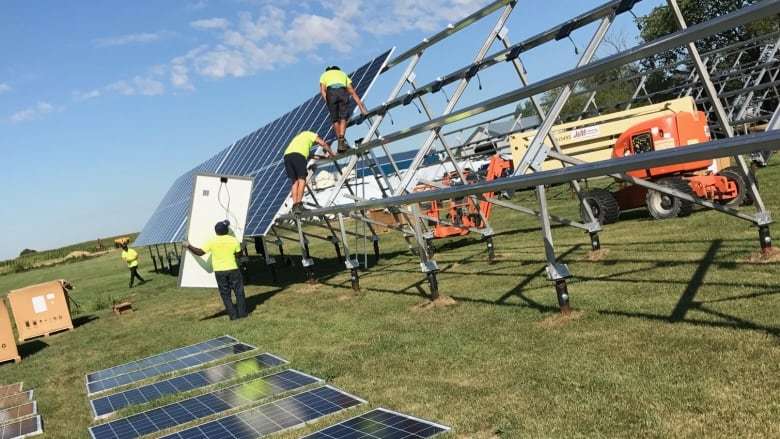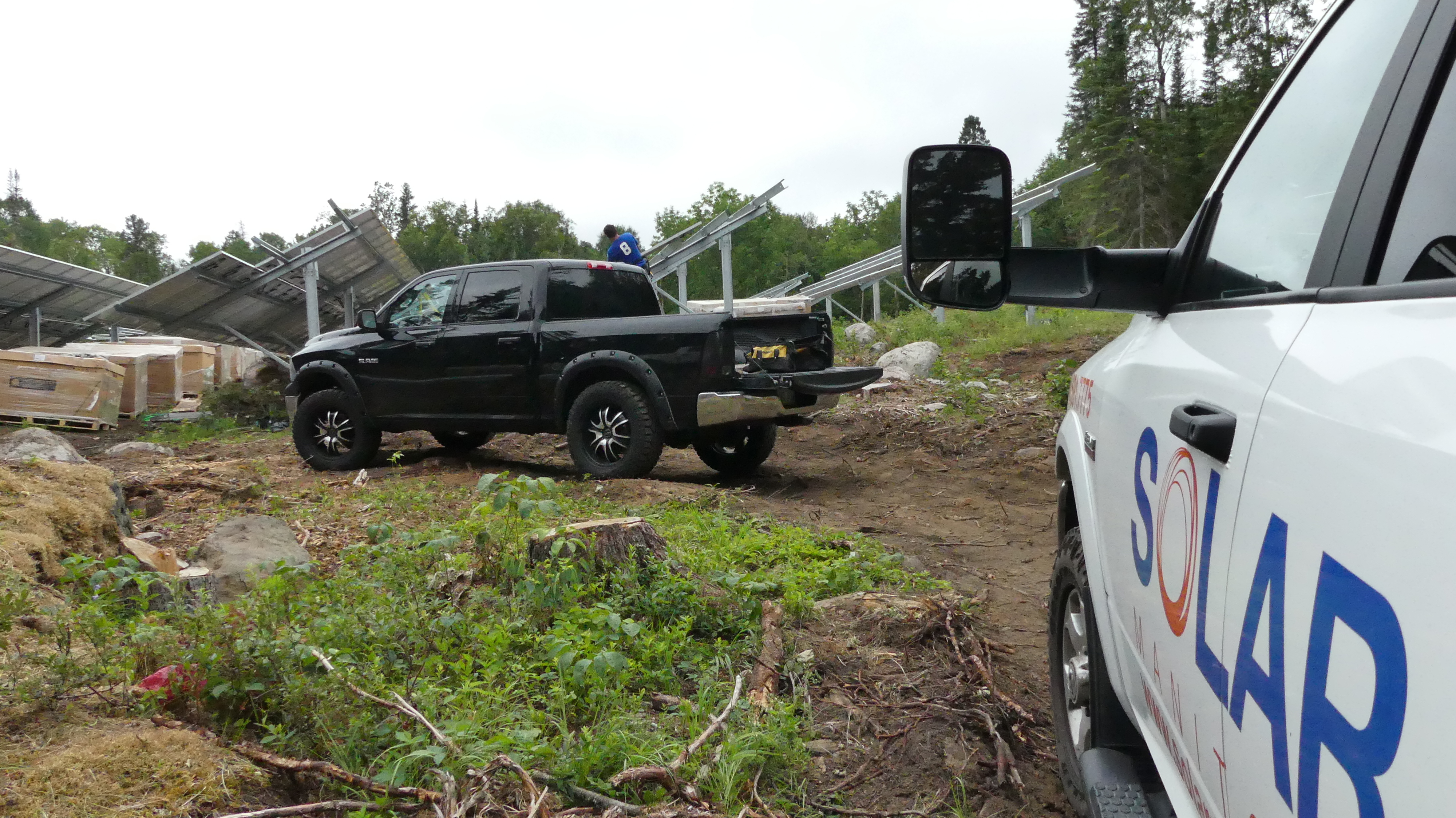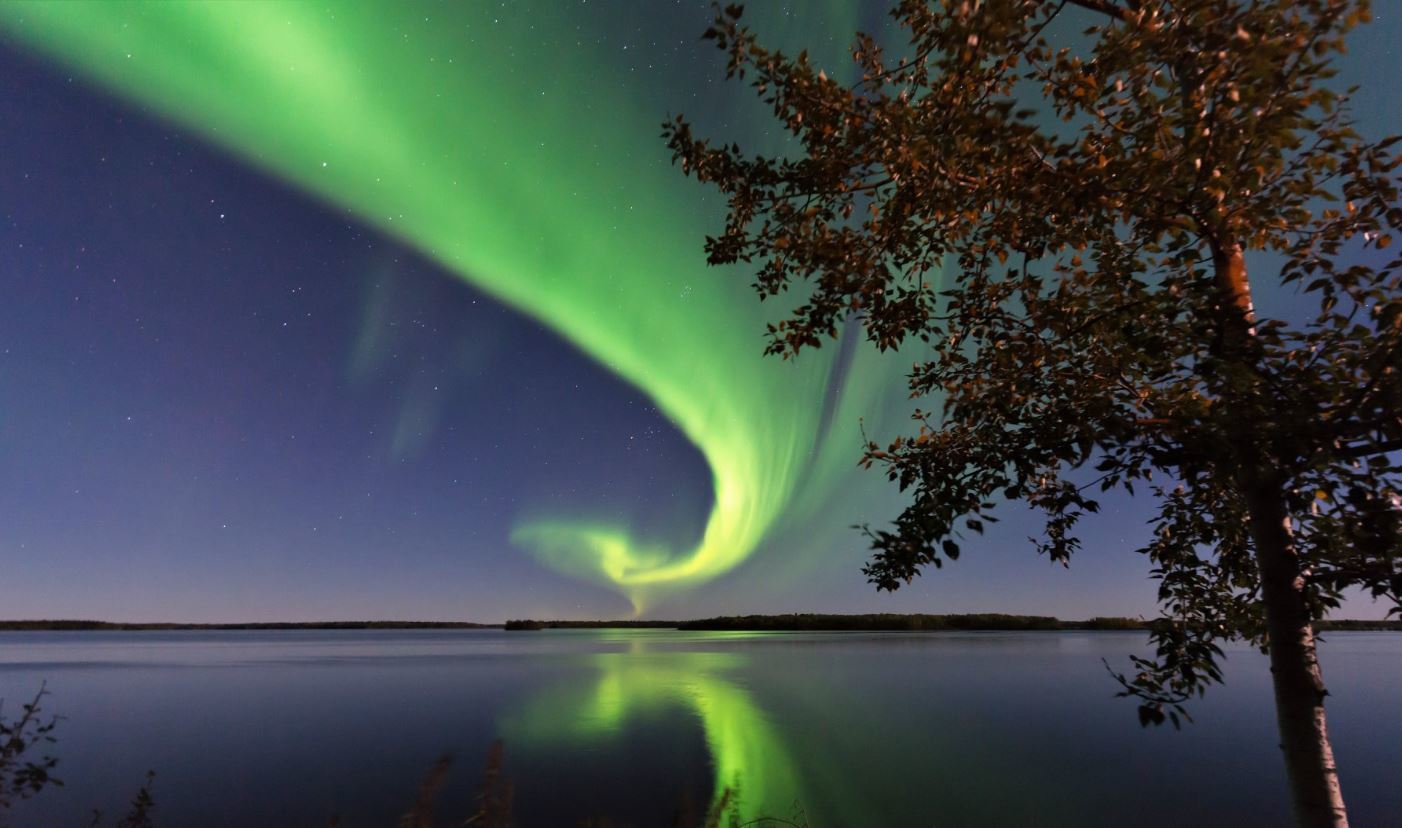August 16, 2018
An array of solar panels fastened to a rocky face above a cluster of cabins in the Canadian Shield is one of several record-shattering projects underway in Manitoba.
The nearly 200 kilowatt, 588-panel system on a hill overlooking the rustic cabins at Tallpine Lodges in West Hawk Lake is just one of dozens of record-tying solar projects planned to come online within the next year.
But this boom year for solar power could quickly go bust, after a subsidy program expired in April with nothing planned to replace it.
When the Tallpine solar project is finished, the lodge's owners say, the panels will take care of all the energy needs for their 15 cabins.
"We have a huge electricity bill, and we've known ever since we bought this resort that we wanted to go solar," said Sacha Harder.

Facing the prospect of soaring electricity rates over the next few years — Manitoba Hydro has said it will seek annual increases of 7.9 per cent until 2023-24 — Sacha and her husband, TJ Harder, decided they needed to make the switch to ensure the survival of their business.
"We're not going to be affected by rising Hydro rates. To date, if we were to pay Ontario rates, we would be nearly out of business, so we'd like to keep the lights on," TJ said.

With a bi-directional meter, the solar panels will feed electricity back into the grid during sunny days, earning credit from Manitoba Hydro, which can then be used in the winter and on cloudy days when energy needs exceed what the panels can produce.
To help with the $550,000 cost of the project, Hydro gave the couple $200,000 through its solar rebate program. If electricity prices keep rising at their current rate, they expect the panels to pay for themselves within 11 years.

Hydro's solar rebate pilot project, which some industry insiders considered the most generous incentive program in the country, spurred a rapid expansion of the province's solar capacity. It offered $1 per watt installed for projects up 200 kW.
The record for biggest solar project won’t last long, because Fisher River Cree Nation has begun construction of a 1 megawatt system — five times the size of the solar installations currently online.
Rapid growth
In 2016, the year the rebate program was introduced, solar made up less than one per cent of the energy produced in Manitoba, according to the National Energy Board.
Patrick Bateman, director of policy and market development for the Canadian Solar Industries Association, says current installed solar capacity in Manitoba adds up to about 5,000 kW. That places the province in about fifth place compared to the solar capacity in other provinces.
It's unclear yet what the total impact of the solar energy rebate pilot project will be, but a total of 57,000 kilowatts worth of projects have been approved. Based on current numbers, if they all came online today, that would catapult Manitoba into second place, behind Ontario.

However, the solar rebate pilot project ended in April, and now installers are uncertain what the future holds.
The rebate program also spurred growth in employment and training for solar panel installers. Justin Phillips, CEO of Sycamore Energy, the parent company of Solar Manitoba, which is installing the panels at Tallpine Lodges, said his company has grown from two employees to 33, and he expects to hire more soon.
He estimates there are about 40 companies installing solar panels in Manitoba, although he also said there has already been a drop in the number since the rebate program ended.
Many new jobs could disappear if the government doesn't introduce another incentive program for consumers, Phillips said.
Setting records
Last year, Solar Manitoba set a new record for the largest solar project in Manitoba, installing a 175 kW system on a farm in Otterburne, Man. Now Phillips says his company has six projects at or near 200 kW planned or installed.

Despite the loss of the rebate, Phillips says he's confident his company will survive.
"We're very comfortable with our market share and the opportunity that it's given us. We feel confident, moving forward, there's still going to be opportunity," he said.
Manitoba Hydro expected to receive up to 100 applications under the pilot project, but ended up with more than 1,550. Hydro approved grants to 83 projects within the range of 175-200 kW.
Most of the applications came from people living in rural areas, particularly on farms.

The City of Selkirk also got in on the rebate program, with plans to have Solar Manitoba install a 200 kW solar system on the roof of the Selkirk Recreation Complex.
Duane Nicol, chief administrative officer for the City of Selkirk, said the panels will save the city about $650,000 in electricity costs over the life of the building, and cut down on greenhouse gas emissions by enabling them to replace the aging natural gas furnace with electric heat.
Before installing the panels, the city needs to reinforce the roof to withstand the added weight.
"It is a pretty substantial array," Nicol said.
Solar Manitoba electrician Imran Khan explains how to install 588 solar panels in the heart of the Canadian Shield.
At Tallpine Lodges, Phillips' crew had to make space for the panels by cutting a clearing in the trees that cover the ridge above the cottages.
They then had to drill the large metal racks into the rock underneath. Due to the noise, the lodge owners shut down their business for the couple of weeks during that phase of construction.
The uneven landscape presented a further challenge. In order to get the panels to extract the maximum amount of power from the sun's rays, Phillips and his crew used software to calculate the best configuration, with some panels facing south and others angled to the southeast.
Both Nicol and the Harders said the solar rebate program was crucial in helping them make the decision to go solar.
"It 100 per cent influenced our decision," Sacha Harder said.
Incentives needed
Canadian Solar Industries policy director Bateman said government incentives are important, as the industry is still in the early stages of development. He'd like to see the Manitoba government create a long-term strategy for solar energy in the province.
"The current situation that we're in, there's a little bit of a vacuum," Bateman said. "[Businesses have] gone off a little bit of an end of a cliff and it's really uncertain for those small businesses, what's going to happen next."
A spokesperson for Manitoba Hydro said the new Crown corporation responsible for energy sustainability, Efficiency Manitoba, will take over responsibility for any renewable energy incentives.
The recently appointed board of Efficiency Manitoba is still in the process of hiring a permanent chief executive officer and establishing a stakeholder advisory committee.
Although Manitoba can expect to see a significant amount of new solar energy produced in the next few years, it remains a small portion of the province's overall energy production.
One of the challenges facing solar companies in Manitoba is the fact that the province already has a surplus of cheap renewable energy from hydroelectric dams, Phillips said.

Solar industry players say the technology can still play a role in the province by reducing demand on the system, freeing up grid capacity for export or to power electric vehicles, and easing strain on the grid during droughts.
Solar systems also make local communities more energy independent, Selkirk CAO Nicol said.
"The more decentralized our power generation in this province, the more decentralized we can build our network, the more resilient it is to things like ice storms and so forth," he said.

The owners of Tallpine Lodges aren't the only people in the area embracing solar energy in a big way. A resort just across the street also recently installed a 200 kW system.
Once their panels begin pumping energy from the sun down the hill to their cottages, the Harders will only need to keep them clear of snow and dust and remove any brush growing underneath.
"We're just going to worry about hail storms and trees falling on our panels," TJ said.
And when the sun shines, they can watch the numbers on their meter rolling backward as they feed energy back into the grid.
Manitoba's solar power industry worries about the future now that a Hydro rebate program has ended.
